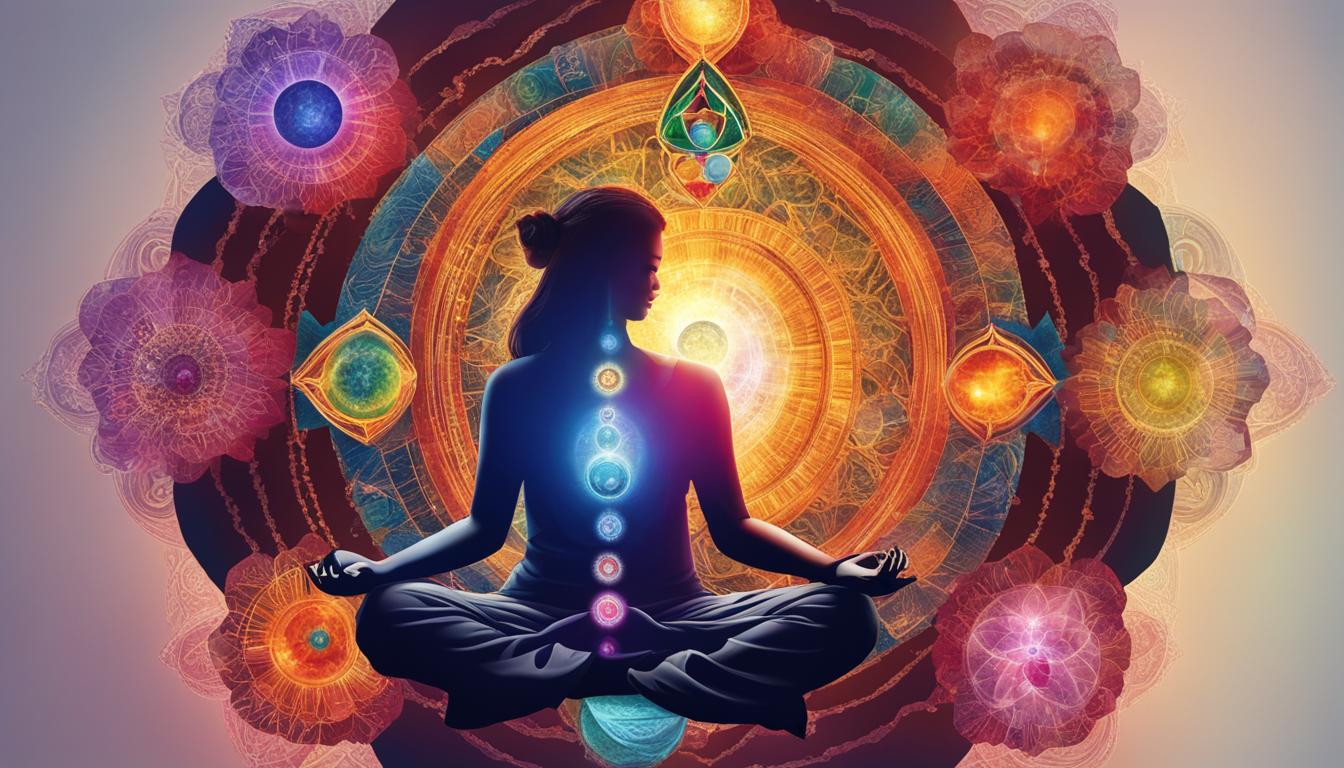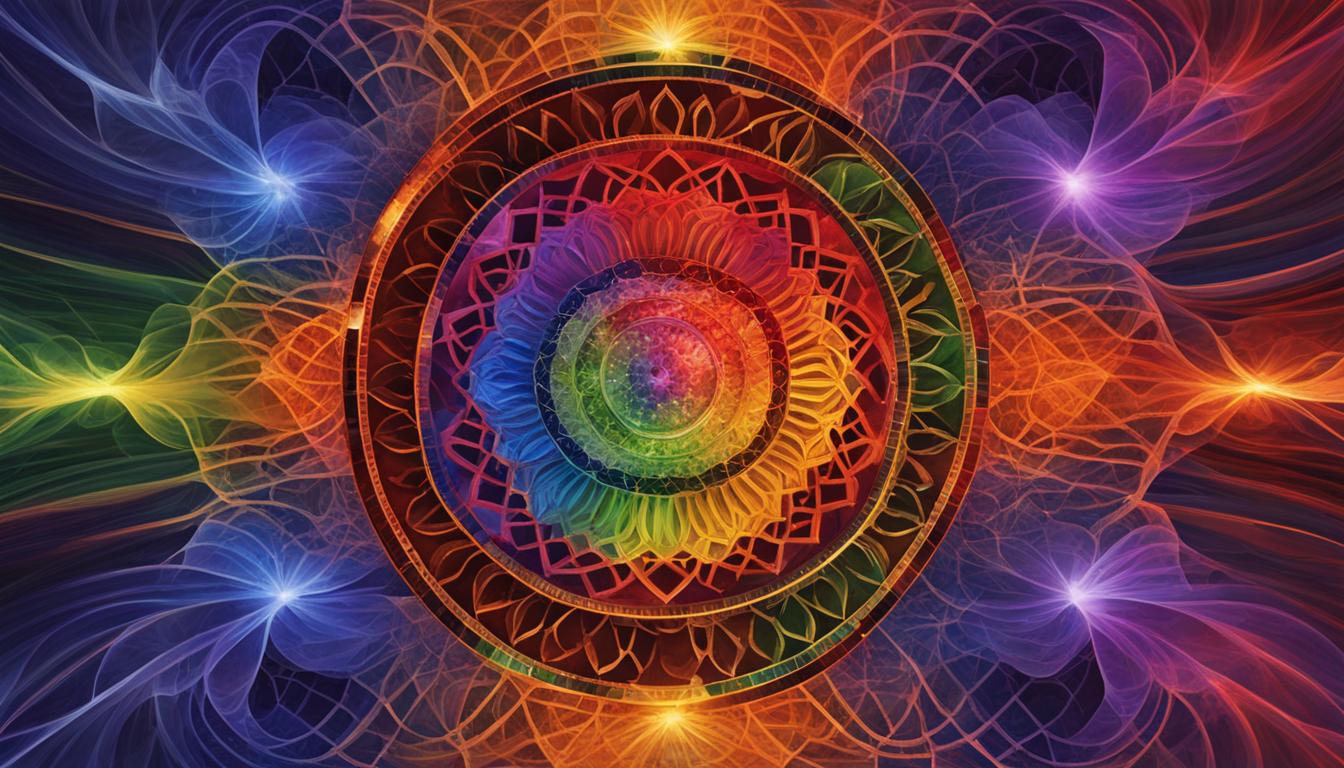Chakras have a rich historical background, dating back to 600 B.C., as mentioned in ancient Yoga Upanishads. The word “chakra” derives from Sanskrit and translates to “wheel,” representing spinning forces of energy within the body. These beliefs suggest that chakras correspond to nerve centers and major organs, with each of the seven chakras holding different abilities, expressions, and types of health.
When chakras become blocked, negative physical, mental, and emotional issues are said to arise. Consequently, many people seek chakra alignment as a means to reduce blockages and improve overall well-being. While the exact prevalence of chakra beliefs remains unknown, it is worth noting that chakra alignment is commonly integrated into yoga, a practice embraced by approximately 9 percent of adults in the United States.
Key Takeaways:
- Chakras have a long history, dating back to 600 B.C., and are believed to correspond to nerve centers and major organs in the body.
- When chakras are blocked, negative physical, mental, and emotional issues may arise, prompting individuals to seek chakra alignment.
- The prevalence of belief in chakras is uncertain, but chakra alignment is commonly integrated into yoga, a practice embraced by around 9 percent of adults in the United States.
The Science Behind Chakra Beliefs
Although there is no scientific evidence to support the existence of chakras or their effects on the body, believers claim to experience physical, mental, and emotional improvements after aligning their chakras. Chakra alignment often involves practices like mindfulness meditation and yoga, which have been proven to have positive effects on physical and mental health.
It is possible that the benefits experienced by believers are due to these practices rather than the alignment of chakras. Additionally, confirmation bias and social influences play a role in maintaining the belief in chakras. Individuals may attribute improvements in well-being to chakra alignment even when other factors, such as decreased stress or increased exercise, may be responsible.
Overall, the scientific community does not recognize or support the concept of chakras.
Despite the lack of scientific evidence, chakra healing practices continue to have a significant following. The belief in chakras is deeply rooted in ancient traditions and personal experiences of well-being. While the scientific validity of chakras remains unresolved, it is important to recognize the role of mindfulness and self-care practices in promoting overall health and well-being.
Chakras and Christianity
The concept of chakras, originating primarily from Hinduism and Buddhism, does not have a direct mention in the Bible. This has led to varying beliefs among Christians regarding their compatibility with their faith. While some Christians view chakras as occult or contrary to their religious teachings, others suggest that there may be valuable wisdom in these ancient practices that should not be completely dismissed.
For Christians who wish to explore the relationship between chakras and Christianity, it is crucial to exercise discernment and deepen their understanding of their faith. Some proponents argue that the energy associated with chakras can be used for God’s purposes. They believe that by inviting the healing presence of Jesus into the body, chakras can be aligned in a way that is in accordance with Christian beliefs.
However, it is essential to approach the integration of chakra practices with caution. Traditional yogic texts that mention chakras often include elements from other religions that may not align with Christian teachings. Therefore, Christians considering the exploration of chakras should be mindful of the potential conflicts and theological inconsistencies that may arise.
Ultimately, the relationship between chakras and Christianity is a complex and individual matter that requires thoughtful consideration. Christians who choose to engage with chakra practices should do so with a strong foundation in their faith, seeking guidance from trusted spiritual leaders and ensuring that the principles and practices they adopt align with the fundamental tenets of Christianity.
FAQ
Why do people believe in chakras?
People believe in chakras because of their long history and association with ancient Yoga Upanishads. The belief is that chakras are spinning wheels of energy in the body that correspond to nerve centers and major organs. Aligning the chakras is believed to improve well-being.
What are the benefits of believing in chakras?
Believers in chakras often claim physical, mental, and emotional improvements after aligning their chakras. While there is no scientific evidence to support chakra existence, practices like mindfulness meditation and yoga, which are often used for chakra alignment, have been proven to have positive effects on overall health.
Is there scientific evidence supporting chakra beliefs?
No, there is no scientific evidence to support the existence of chakras or their effects on the body. The benefits experienced by believers may be attributed to practices like meditation and yoga rather than chakra alignment specifically. Confirmation bias and social influences can also play a role in maintaining belief in chakras.
What is the relationship between chakras and Christianity?
Chakras primarily originate from Hinduism and Buddhism and do not have a direct mention in the Bible. Some Christians view chakras as occult or incompatible with their faith, while others believe there may be wisdom in these teachings. Christians should exercise discernment and be knowledgeable about their faith when exploring concepts like chakras.
Can chakras align with Christian beliefs?
Some Christians argue that energy can be used for God’s purposes and believe in aligning chakras in accordance with Christian teachings. However, caution is advised as traditional yogic texts that involve chakras often incorporate elements from other religions that may not align with Christian beliefs. The relationship between chakras and Christianity is complex and individual.




